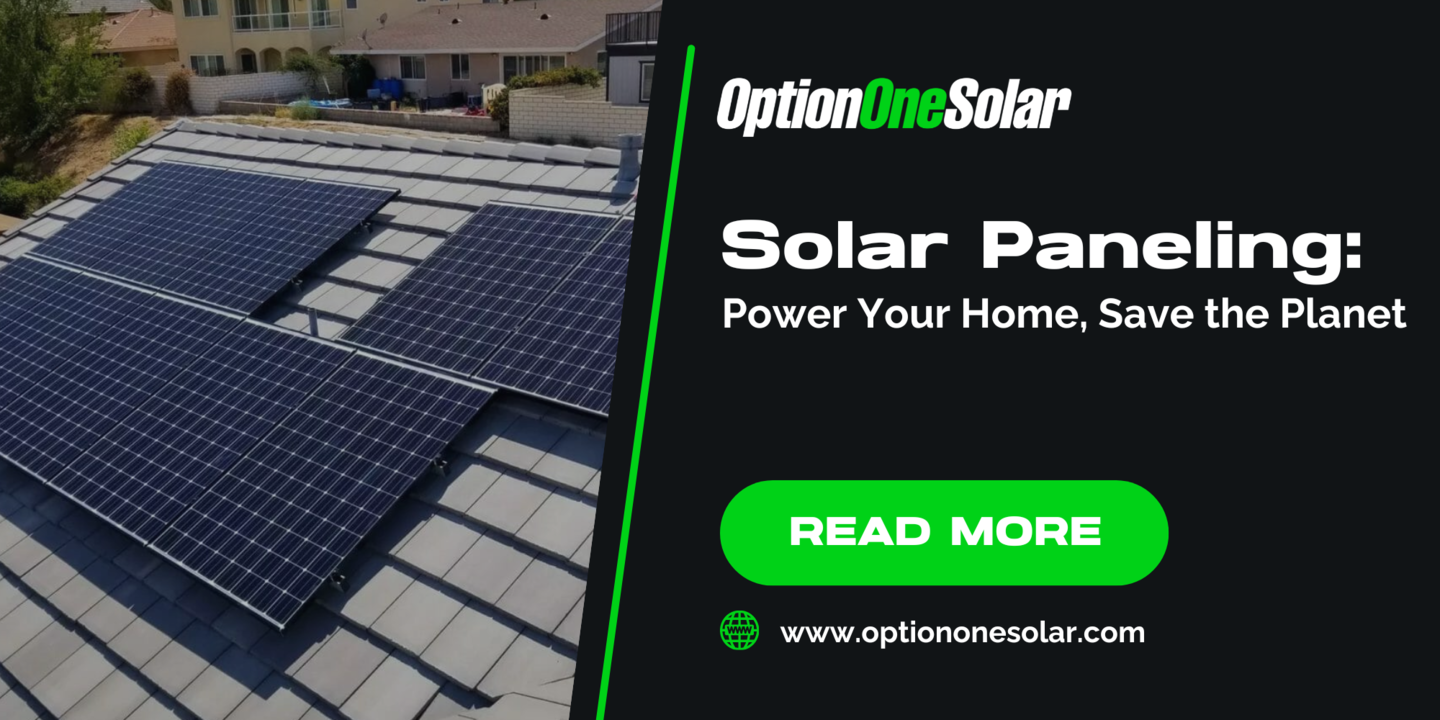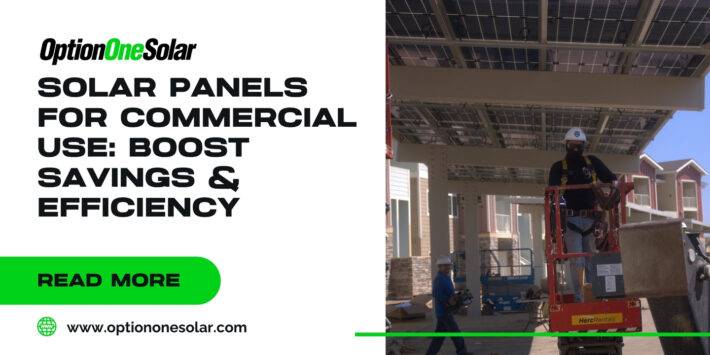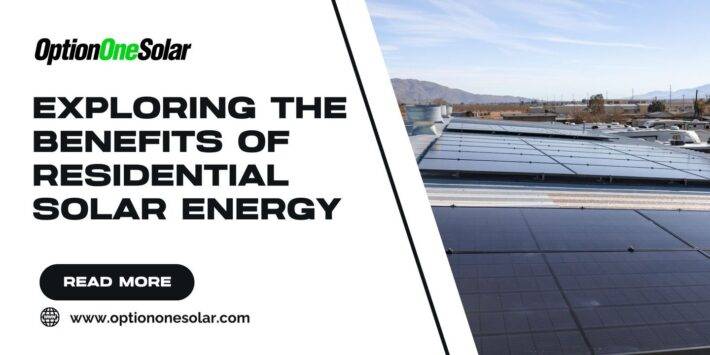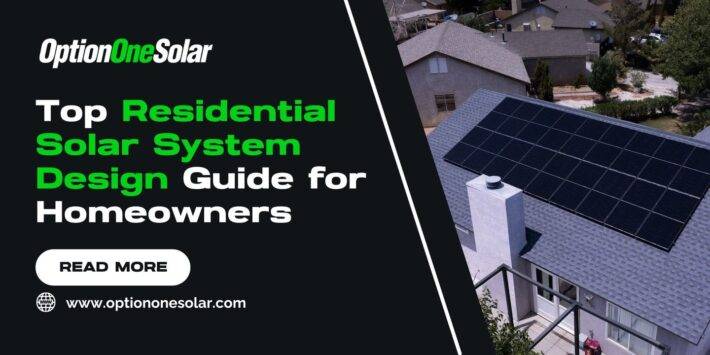Are you sick and tired of outrageous electric bills that keep climbing higher? With Option One Solar's solar paneling solutions, you can transform your home into a lean, green, energy-generating machine.
You'll slash your utility expenses and reduce your carbon footprint at the same time.
Ready to harness the sun’s power and reduce your energy bills? Contact Option One Solar today to find out how solar paneling can be tailored to fit your needs.
What Are Solar Panels and How Do They Work?
Solar panels are changing the game in renewable energy. By harnessing sunlight, they create clean electricity for homes and businesses.
But how do these technological wonders actually function?
At the heart of a solar panel system are silicon solar cells that absorb sunlight and convert it into direct current (DC) electricity.
This DC electricity is then sent to an inverter, which converts it into alternating current (AC) electricity suitable for powering your home.
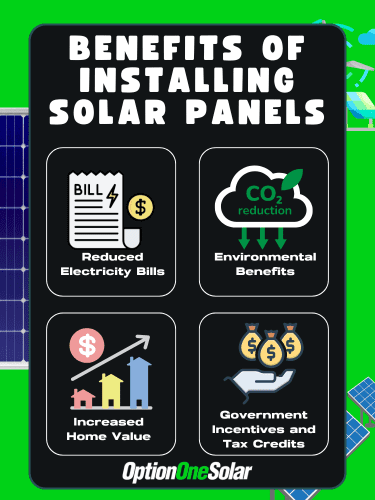 Benefits of Installing Solar Panels
Benefits of Installing Solar Panels
Reduced Electricity Bills
One of the biggest perks of solar panels is the potential to slash your electricity bills.
Generating your own power means you'll rely less on the grid, saving money and shielding yourself from rising energy prices.
Many solar-powered homes even eliminate their utility bills.
Environmental Benefits
Solar power is a green, renewable energy source that doesn't emit greenhouse gases or other pollutants.
By choosing solar paneling, you're not only cutting costs but also reducing your carbon footprint and helping combat climate change.
Cleaner air and a healthier planet are significant benefits for everyone.
Increased Home Value
Solar paneling can increase your home’s value. Homes with solar panels sell for an average of 4.1% more than comparable homes without solar, translating to thousands of dollars in added value.
This makes solar panels a smart investment in your property.
Government Incentives and Tax Credits
Various government incentives and tax credits make investing in solar more affordable.
The federal solar tax credit can reduce your installation costs by 30%, and many states offer additional rebates, grants, and performance-based incentives.
Types of Solar Panels
Monocrystalline Solar Panels
Monocrystalline panels are the most efficient and powerful. Made from a single silicon crystal, they offer high conversion rates and perform well in low-light conditions.
However, they are also the most expensive option.
Polycrystalline Solar Panels
Polycrystalline panels are made from multiple silicon crystals, making them a more budget-friendly option.
They are slightly less efficient than monocrystalline panels and have a blue, speckled appearance.
Thin-Film Solar Panels
Thin-film panels are lightweight and flexible, ideal for unique applications like RVs and boats.
They are the least efficient but the most affordable, requiring more space to generate the same amount of electricity as other types.
Factors to Consider When Choosing Solar Panels
Cost and Budget
Solar panel costs vary widely. On average, a residential system costs between $10,000 and $20,000.
Long-term savings on energy bills and available incentives can offset these upfront costs. Financing options can also make solar more affordable.
Efficiency and Performance
Higher efficiency panels convert more sunlight into usable electricity, making them ideal for limited roof space.
Performance refers to how well panels hold up over time and in different weather conditions. Look for panels with a strong track record and a comprehensive warranty.
Warranty and Durability
Choose panels with a robust warranty that covers defects and performance for at least 25 years.
Panels should be tested to withstand harsh weather conditions, ensuring longevity and reliability.
Brand Reputation
Select panels from reputable manufacturers with a history of quality products and good customer service. Look for certifications from trusted organizations like the Solar Energy Industries Association (SEIA).
For more information on choosing the right solar panels and solar paneling programs, visit Option One Solar.
Solar Panel Installation Process
Site Assessment and Design
The first step in installation is a site assessment to determine the best location to install solar panels. Installers will design a system tailored to your energy needs and specifics of your site.
Permits and Approvals
You'll need permits and approvals from local authorities and your utility company. Your installer can usually handle this paperwork, but it's to allow time for this step.
Installation Steps
After securing permits, the solar installation process begins with preparing your roof and mounting the panels. The panels are then connected to the inverter and your electrical system.
Connecting to the Grid
Finally, your solar paneling system will be connected to the grid. This allows you to use solar power and potentially earn credits for excess electricity produced.
Maintaining and Troubleshooting Solar Panels
Regular Cleaning and Inspection
To keep your solar panels working at their best, clean them regularly to remove dust and debris. Regular inspections can help spot and fix any damage, ensuring they stay efficient for a long time.
Monitoring System Performance
Use monitoring software to track how much energy your panels produce and how much you use. This can help you spot any problems early and get them fixed quickly.
Common Issues and Solutions
Common issues include faulty charge controllers or damaged batteries. Regular maintenance and quick repairs can keep your system running smoothly.
DIY Solar Panel Installation vs. Professional Services
Advantages and Disadvantages of DIY Installation
DIY installation can save you money, but it requires significant electrical and construction skills. Mistakes can reduce efficiency and compromise safety.
For most people, professional installation from solar companies is a safer and more reliable choice.
When to Choose Professional Services
Professional installers ensure your system is designed and installed correctly, maximizing efficiency and safety. They can also help you navigate incentives and financing options.
FAQs about Solar Paneling
How many solar panels are needed to power a house?
The number varies based on energy use and sunlight. Typically, a home needs 20-25 panels to cover its electricity bills.
Are solar panels worth it?
Solar panels can significantly cut your energy consumption and offer savings over time, making them a smart investment for many homeowners.
What are the three types of solar panels?
The main types include monocrystalline, polycrystalline, and thin-film amorphous silicon solar panels.
Embrace Solar Power for a Brighter, Greener Future
Solar paneling offer an excellent way to harness renewable energy, bringing many benefits such as lower electricity bills, a cleaner environment, higher home value, and various government incentives.
By understanding how solar panels work—from converting sunlight into usable electricity to the different types available—you can make better choices for your home.
When picking solar panels, think about the cost, efficiency, warranty, and brand reputation to get a reliable and effective system.
Whether you choose professional installation or a DIY approach, regular maintenance and monitoring are essential to keep your solar energy system working well.
Using solar power not only helps you become more energy-independent but also supports a cleaner, healthier planet for future generations.
Transform your energy solution with Option One Solar. Contact us today for a free quote! Your future of cleaner, more affordable energy awaits.

